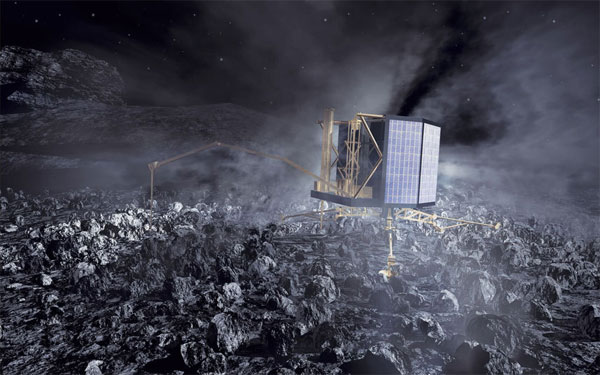The Philae robot falls into the state of
After two days of landing on the surface of a comet, Philae was in a state of "hibernation" due to the exhaustion of energy.
>>>Philae robots send signals from comets to Earth
The European Space Agency (ESA) said that because Philae's battery was exhausted and not enough sunlight to maintain energy, it had fallen into an inactive mode. In this state, all devices and systems are off.

Simulate Philae's activity on the comet surface.(Photo: ESA)
Scientists estimate that the comet's lighting time is 7 hours a day. However, the real lighting time is only 1.5 hours and not enough to supply the battery system.
According to CNN, the team attempts to improve the energy state for Philae by passing commands to change the body configuration. The main body of the robot is enhanced and rotated 35 degrees to maximize the ability to receive light for the panels. Conditions can change if the comet moves closer to the Sun and provides the necessary amount of light.
Despite the pause, Philae transmitted data and black and white images to Earth. The ESA expert team said about 80% of the basic goals were achieved.
The European Space Agency's (ESA) exploration robot landed on the comet surface of 67P / Churyumov-Gerasimenko on November 12. This is the first time the world space science has achieved this achievement.
- Philae robot
- Robot from European spacecraft has set foot on comet
- Scientists bid farewell to Philae comet robot
- The first clear comet surface images of mankind
- The Philae robot sends signals from comets to Earth
- The Sao Chupet probe works again in March
- Earth water does not come from comets
- 10 most exotic waterfalls in the world
- Video: The figure of the Boston Dynamics Atlas robot is very well balanced and hard to fall
- Found exploration robots stuck for two years on comets
- Stop all communications with Philae probe
- The beauty of Niagara Falls paradise
 Van Allen's belt and evidence that the Apollo 11 mission to the Moon was myth
Van Allen's belt and evidence that the Apollo 11 mission to the Moon was myth The levels of civilization in the universe (Kardashev scale)
The levels of civilization in the universe (Kardashev scale) Today Mars, the sun and the Earth are aligned
Today Mars, the sun and the Earth are aligned The Amazon owner announced a secret plan to build a space base for thousands of people
The Amazon owner announced a secret plan to build a space base for thousands of people